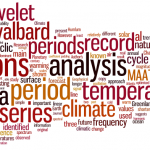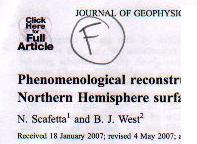The title of this post might seem like a truism, but for about a decade some people have claimed the opposite, and many people have spent much time and effort trying to understand why. Much of that effort was wasted.
[Read more…] about Cold extremes do in fact decrease under global warmingSearch Results for: scafetta
ACRIM vs PMOD
 )
) Two recent papers (Lockwood & Fröhlich, 2008 – ‘LF08’; Scafetta & Willson, 2009 – ‘SW09’) compare the analysis of total solar irradiance (TSI) and the way the TSI measurements are combined to form a long series consisting of data from several satellite missions. The two papers come to completely opposite conclusions regarding the long term trend. So which one (if either) is right, then? And does it really matter?
Curve-fitting and natural cycles: The best part

It is not every day that I come across a scientific publication that so totally goes against my perception of what science is all about. Humlum et al., 2011 present a study in the journal Global and Planetary Change, claiming that most of the temperature changes that we have seen so far are due to natural cycles.
They claim to present a new technique to identify the character of natural climate variations, and from this, to produce a testable forecast of future climate. They project that
the observed late 20th century warming in Svalbard is not going to continue for the next 20–25 years. Instead the period of warming may be followed by variable, but generally not higher temperatures for at least the next 20–25 years.
However, their claims of novelty are overblown, and their projection is demonstrably unsound.
[Read more…] about Curve-fitting and natural cycles: The best part
References
- O. Humlum, J. Solheim, and K. Stordahl, "Identifying natural contributions to late Holocene climate change", Global and Planetary Change, vol. 79, pp. 145-156, 2011. http://dx.doi.org/10.1016/j.gloplacha.2011.09.005
Bending low with Bated breath
“Shall I bend low and in a bondman’s key,
Shylock (Merchant of Venice, Act 1, Scene 3)
With bated breath and whisp’ring humbleness…?”
As dark nights draw in, the venerable contrarians at the GWPF are still up late commissioning silly pseudo-rebuttals to mainstream science. The latest, [but see update below] which no-one was awaiting with any kind of breath, is by Dr. Ray Bates (rtd.) which purports to be a take-down of the recent #SR15 report. As Peter Thorne (an IPCC author) correctly noted, this report is a “cut-and-paste of long-debunked arguments”. I’ve grown a little weary of diving down to rebut every repetitive piece of nonsense, but this one has a few funny aspects that make it worthwhile to do so.
When they go low, we go “sigh…”.
[Read more…] about Bending low with Bated breathA phenomenological sequel

Does climate sensitivity depend on the cause of the change?
Can a response to a forcing wait and then bounce up after a period of inertness?
Does the existence of an 11-year time-scale prove the existence of solar forcing?
Why does the amplitude of the secular response drop when a long-term trend is added?
[Read more…] about A phenomenological sequel
More solar shenanigans*
Going back a few months, I spent a bit of time pointing out the strategy and nonsense in the various Willie Soon and company’s efforts to blame current warming on solar activity. I specifically pointed out their cultish devotion to a single solar activity reconstruction (Hoyt and Schatten, 1993) (HS93); with an update from Scaffeta (2023), and their increasingly elaborate efforts to create temperature series that correlate to it.
Well, Theodosios Chatzistergos has just published a deep dive into the HS93 reconstruction (Chatzistergos, 2024) (C24) and… let’s say the results will not be surprising to regular readers.
[Read more…] about More solar shenanigans*References
- D.V. Hoyt, and K.H. Schatten, "A discussion of plausible solar irradiance variations, 1700‐1992", Journal of Geophysical Research: Space Physics, vol. 98, pp. 18895-18906, 1993. http://dx.doi.org/10.1029/93JA01944
- N. Scafetta, "Empirical assessment of the role of the Sun in climate change using balanced multi-proxy solar records", Geoscience Frontiers, vol. 14, pp. 101650, 2023. http://dx.doi.org/10.1016/j.gsf.2023.101650
- T. Chatzistergos, "A Discussion of Implausible Total Solar-Irradiance Variations Since 1700", Solar Physics, vol. 299, 2024. http://dx.doi.org/10.1007/s11207-024-02262-6
Live (almost) from AGU–Dispatch #6
Today was the all-Union session on Tipping Points, and several people have asked for comments on what went on there. I suppose this session might have been useful for people who had to miss the more detailed discussion in specialized sections, but I don’t have much to say about most of the talks, since they for the most part went over issues like ice sheet dynamics and rapid arctic sea ice loss, which I’ve discussed in earlier dispatches. Myself, I never found the notion of “tipping points” to be a very useful contribution to public discourse. The concept is ill-defined and very prone to be misunderstood — as in: we’ve passed a tipping point so it’s too late to do anything (might as well have a party). In Hansen’s talk, he did try to clarify what he meant by a tipping point. His notion of this has less to do with what mathematicians understand as “bifurcations,” and more to do with a kind of inertia in the climate system. He means things like having passed a threshold of CO2 which, given warming in the pipeline and the lifetime of CO2, commits a certain discrete event — e.g. loss of perennial sea ice or the Amazon rainforest– to occurring even if we were to later reduce emissions to zero. He tried to distinguish between reversible and irreversible tipping points. The talk was good cheerleading, after a fashion, but rather thin on real examples of what might be a tipping point in his definition. Everything he said was true (especially the emphasis on the importance of a rapid phase-out of coal burning) but the talk had much more to do with energy policy and lamentation of the power of entrenched fossil fuel interests than it had to do with climate science.
[Read more…] about Live (almost) from AGU–Dispatch #6
The obvious answer
Climate science appears to be just like any other science. At least, this is the conclusion from a fresh publication by Marianne Ryghaug and Tomas Moe Skjølsvold (“The global warming of climate science: Climategate and the construction of scientific facts” in International studies in the philosophy of science). This finding is not news to the research community, but this analysis still hints that everything is not as it should be – because why would anyone report from a crime scene if the alleged crime has not even been committed?
Les Chevaliers de l’Ordre de la Terre Plate, Part II: Courtillot’s Geomagnetic Excursion
 )
) This article continues the critique of writings on climate change by Allègre and Courtillot, started in Part I . If you would like to read either post in French, please click on the flag icon beside the post title above.
Prelude: It’s the physics, stupid
…which of course is a paraphrase of Bill Clinton’s famous quote regarding the economy. We put the last word in small letters since we’ve learned that it is not a good debating technique to imply (even inadvertently) that those who are having trouble seeing the force of our arguments might be stupid. What we wish to emphasize by this paraphrase is the simple fact that the expectation of a causal link between increasing long-lived greenhouse gases (like CO2) and increasing temperature does not rest on some vague, unexplained correlation between 20th century temperature and 20th century greenhouse gas concentration.
The anticipated increase in temperature was predicted long before it was detectable in the atmosphere, indeed long before it was known that atmospheric CO2 really was increasing; it was first predicted by Arrhenius in 1896 using extremely simple radiation balance ideas, and was reproduced using modern radiation physics by Manabe and co-workers in the 1960’s. Neither of these predictions rests on general circulation models, which came in during subsequent decades and made more detailed forecasts possible.
Still, the basic prediction of warming is founded on very fundamental physical principles relating to infrared absorption by greenhouse gases, theory of blackbody radiation, and atmospheric moist thermodynamics. All these individual elements have been verified to high accuracy in laboratory experiments and field observations. For a time, there was some remaining uncertainty about whether water vapor feedback would amplify warming in the way hypothesized in the early energy balance models, but a decade or two of additional observational and theoretical work has shown that there is no real reason to doubt the way in which general circulation models calculate the feedback. When modified by inclusion of the cooling effect of anthropogenic aerosols, the theory gives a satisfactory account of the pattern of 20th and 21st century temperature change.
No other theory based on quantified physical principles has been able to do the same. If somebody comes along and has the bright idea that, say, global warming is caused by phlogiston raining down from the Moon, that does not make everything we know about thermodynamics, infrared absorption, energy balance, and temperature suddenly go away. Rather, it is the job of the phlogiston advocate to quantify the effects of phlogiston on energy balance, and incorporate them in a consistent way beside the existing climate forcings. Virtually all of the attempts to poke holes in the anthropogenic greenhouse theory lose sight of this simple and unassailable principle.
In a paper entitled "Are there connections between the Earth’s magnetic field and climate?" published recently in Earth and Planetary Science Letters, Courtillot and co-authors attempt to cast doubt on carbon dioxide as a primary driver of recent (and presumably future) climate change; he argues instead that fluctuations in the Earth’s magnetic field (partly driven by solar variability) have an important and neglected role. Like most work of this genre, it is carried out in an intellectual void — as if everything we know currently about physics of climate had to be set aside in order to make way for one new (or in fact not-so-new) idea. But the problems don’t end there. With the help of a Comment published by Bard and Delaygue (available here at EPSL or here as pdf) , we’ll expose a pattern of suspicious errors and omissions that pervades Courtillot’s paper. Sloppiness and ignorance is by far the most charitable interpretation that can be placed on this pattern.